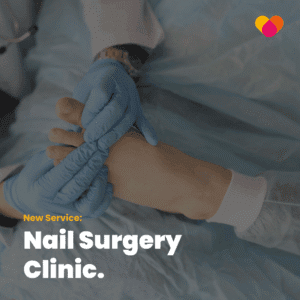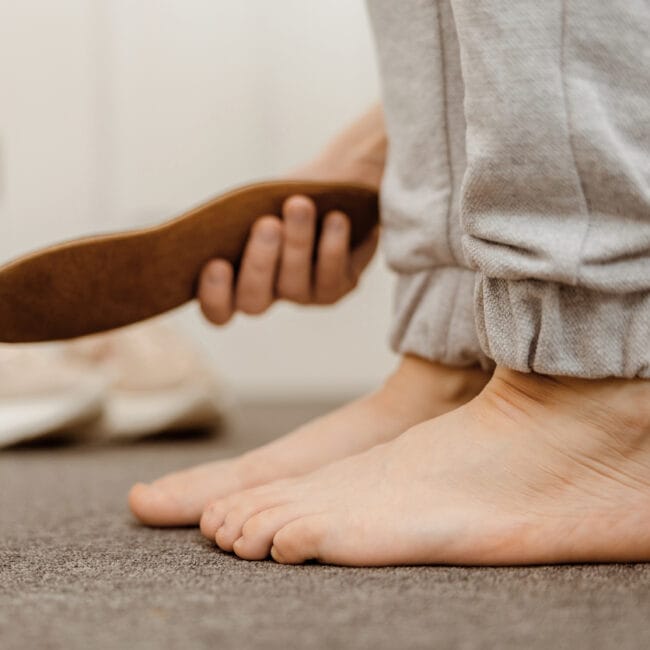Is there something on your foot that is bothering you? Is it painful? Do you want to know what it is and how to get rid of it? Here we discuss the differences between a corn, a callus and a verruca.
What Is A Callus?
A callus is an area of thick, hardened skin that develops over time in response to pressure or friction. As it occurs in areas of high pressure and contact, they appear on the hands and feet. It can develop over larger areas like across the ball of the foot or around the heel. It generally has a yellow appearance and can look waxy or rough. While callus doesn’t present a long-term or serious health risk, it can cause discomfort, irritation and look unattractive.
What Is A Corn?
Corns are smaller than calluses and usually have a hard and thickened centre. It is usually circular in appearance, grows inwards in a cone shape which is why they are usually painful when pressed. It is sometimes surrounded by red, inflamed skin due to constant pressure from footwear, typically narrow shoes or high heels. Corns form where there is a peak of pressure. It is your body telling you to change something – like your shoes – to prevent this from occurring in the future. They typically develop where a callus exists, usually on the balls of the foot or on the toes.
Hard corns are just that, hard or waxy skin. Soft corns may also occur – these develop between the toes due to moisture and have a white, soggy skin appearance. A good tip is to apply surgical spirits to those soft corns between the toes before seeing your podiatrist. This tip will help harden the skin and make the corn removal quicker and easier on you.
Calluses and corns tend to form on high pressure areas like bony prominences. So things like bunions and hammer toes increase the likelihood of developing corns and calluses. This is different to a verruca, which can occur at any area and generally need to have a break to the skin surface to penetrate and develop.
What Is A Verruca?
A verruca is a wart usually found on the sole of the foot that has a circular cauliflower shape. They are usually raised and sometimes they have black dots, which are due to little blood vessels. These black dots don’t always occur, but they are a good way of diagnosing a verruca if they are present. If you look closely at the verruca you will see the striae (lines on the foot that look like a finger print) do not go over the surface of the verruca, they only surround it. This differentiates them from corns or calluses where the striae (lines) continue over the surface of the skin. A verruca can occur on its own or in a cluster, which is referred to as mosaic verrucae.
Verrucae, like corns, can be quite painful to walk on if on the soles of the feet, which is often why people seek treatment. Some verrucae may disappear over time, which is different to corns, which need to be removed as they won’t go away without treatment. Another test to distinguish between these two “lumps” on your feet is the squeeze test. Corns are sore to press directly, while verrucae are more painful when squeezed.
How to Avoid Callus And Corns
Removing the cause of the pressure is generally the way to avoid reoccurrence. Here are some tips to keeping your feet in tip-top shape.
Wearing wider, round toed, comfortable shoes. Ensuring you have enough space across the toes and ball of the foot and enough depth in the front of the shoes should prevent corns from developing. If you are unable to wiggle or “play the piano” with your toes, your shoes are too tight and you should stop wearing them.
Wearing thicker socks may offer more protection when running, reducing friction which can cause callus and corns. Wearing footwear without socks can cause friction and rubbing.
Soaking your feet in warm, soapy water for about 15 mins can help remove calluses by softening the skin. File the rough skin with a pumice stone to remove thicken layers of skin more easily after soaking.
Keeping your feet moisturised with foot cream can prevent calluses or corns. A foot cream containing urea is best as it soaks into the deeper layers of the skin. Do not apply foot cream between the toes, as moisture there can cause soft corns and athlete’s foot.
Wearing protective coverings such as circular felt ring pads to offload the corn, or chiropody felt to cover areas of friction or pressure can be used preventatively.
Wearing cotton or lambswool between the toes is an easy way to absorb moisture and prevent the toes from touching. Gel toe dividers are another option to place between the toes and available in pharmacies- however, some can be quite thick, may be uncomfortable and may move around in shoes. Wool is conformable and more comfortable to wear, but must be changed daily for good foot hygiene.
Should I Apply A Corn Plaster?
Podiatrists are experts in foot care and do not advise use of corn plasters. This is because an individual may have an undiagnosed health condition such as diabetes. Corn plasters contain an acid, usually salicylic acid, which does not know the difference between the corn and healthy skin. It can cause a chemical burn and wounds to the feet which may be difficult to heal due to poor circulation, particularly if you have diabetes. The safest way to treat a corn is to attend a podiatry appointment, where it can be removed in one visit.
What Can A Podiatrist Do For Me?
If you don’t know if you have a corn, a verruca or a callus, a podiatrist can diagnose this for you and provide you with advice.
A podiatrist can remove callus and corns with a scalpel. It is important to note they can reoccur if the cause of the pressure remains the same e.g. continuing to wear narrow shoes.
Customised silicone devices can be made for between the toes. These are reusable and should be worn in footwear. This device will help reduce skin on skin contact between toes which will prevent soft corns.
A podiatrist can also offer semi-compressed felt to offload areas in the foot. While it is a temporary measure lasting usually only a few days, it can be applied to footwear in some cases and can last up to a few weeks. Think of this as a trial run to see how you can benefit from them as if this method works, and customised insoles could work for you in the longer term.
Customised orthotics are tailor made insoles, which can be designed with pads and cutouts to offload pressure from callus and corns, aiming to prevent the corn from occurring or slowing its development. We advise insoles for this reason, aiming to elongate the time between podiatry visits for routine foot care.
A podiatrist can treat a verruca by examining the feet, to ensure they are treating all of the verrucae present. They remove the skin on top of a verruca with a scalpel and apply a professional acid treatment. Spectrum Health has a few treatment options available for verrucae. The podiatrist can explain the treatment options and advise which is the most suitable for you. However, as it is a virus, multiple treatments may be required depending on the size and length of time the verruca is present.














